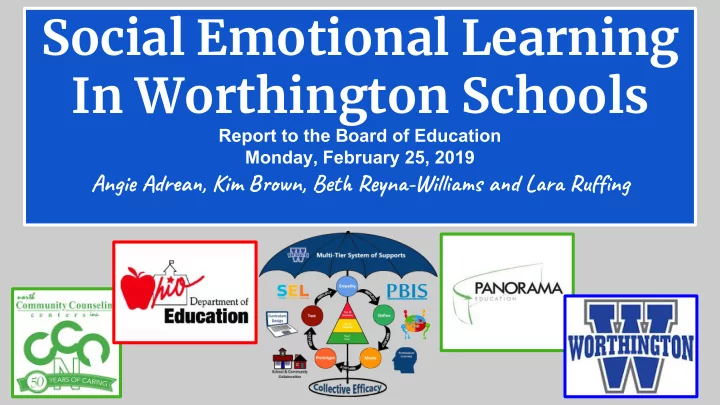

Social Emotional Learning In Worthington Schools Report to the Board of Education Monday, February 25, 2019 An�i� ��r�a�, Kim ����n, Bet� ���n�-Wil����s a�� L�r� �u���n�
What is SEL? Social and emotional learning (SEL) is the process through which children and adults understand and manage emotions, set and achieve positive goals, feel and show empathy for others, establish and maintain positive relationships, and make responsible decisions. Collaborative for Academic, Social, and Emotional Learning ( CASEL )
And lead to these Affect these areas... SEL Practices... outcomes... ● Infused into content Knowledge and Improved Behavior Skills ● Integrated into teaching practice ● PBIS Learning Reduced Emotional Environment Distress ● MTSS Explicit instruction ● of SEL strategies Improved Attitudes Academic Building CIP ● Performance
Worthington Mental Health Specialist Team Amanda Cooksey Sarah Detling Lara Ruffing Brandy Wells Martha Wessell Betsy Youse Erin Zelinski-Righter
Worthington Mental Health Specialist Team
Worthington School Counselor Team HIGH SCHOOL MIDDLE SCHOOL ELEMENTARY * Mental Health Support * High School Planning * 9 Preventative lessons per class *College/Career *Mental Health Support * Small Group Advising Intervention Sessions *Academic Support (Grief, Social Skills, *Academic Support Conflict Resolution) *MTSS Process *Tracking Graduation * Individual Support *Individual Support Plans Plans *504 Plans *Community Connections * MTSS Process *Individual Support Plans * Small Group Intervention *Interface/Coordinate Sessions community support *Community services Connections *504 Plans
Worthington School Psychologist Team Our School Psychologists work collaboratively with their school building teams to help create safe and supportive learning environments for all students. MTSS (Multi-Tiered Support System) ○ Interventions and progress monitoring systems . ■ Educational Disabilities ○ Evaluation team reports for special education services and 504 . ■ SEL Activities ○ Den of Ten/Family Groups/Cougar Pride Groups ■ Phonemic awareness groups/social skills ■ HOPS (Homework, Organization and Planning Skills) ■ After school clubs ■
Building a Professional Learning Network with Neighboring Districts 
Grades 3-5 Highest and Lowest % Questions on the Fall 18-19 Survey Teacher-Student Relationships 90% (+2) How respectful is your teacher towards you? 65% (0) If you walked into class upset, how concerned would your teacher be? Sense of Belonging 83% (+2) How much support do the adults at your school give you? 64% (+5) How much respect do the students at your school show you?
Grades 6-12 Highest and Lowest % Questions on the Fall 18-19 Survey Teacher-Student Relationships 89% (+2) How many of your teachers are respectful towards you? 56% (+5) If you walked into class upset, how many of your teachers would be concerned? 55% ( +4) How many of your teachers would you be excited to have again in the future? Sense of Belonging 57% (+2) Overall, how much do you feel like you belong at your school? 39% (+1) How connected do you feel to the adults at your school?
Worthington Hills Elementary All students are engaged and active learners who have a sense of belonging, positive teacher-students relationships, growth mindset, the ability to self-regulate, and are self-aware. Educators, students, and families work together to create a culture of empathy and support that scaffolds all students’ academic, social and emotional success. Responsive Classroom Practices - morning meetings, interactive modeling, ➢ teacher language, academic choice, interactive learning structures, energizers, closing circle, use of signals etc. Teach, Monitor, Model and Support the PBIS Expectations through the 7 ➢ Virtues and the ‘Hawkeye Way’ Implement the Executive Functioning Curriculum in all classrooms ➢
High School Example
Middle School Example
Elementary Example ● Monthly activities to create a sense of belonging ● Monthly “No One Eats Alone Tables” in the cafeteria ● Announcements and service projects led by student leaders ● Alignment of work with 7 Core Virtues and Responsive Classroom structures “HEY DAY” -- each school member wore this name tag in order to build a sense of connection by calling people ● Staff focus on Culture, Climate, and by their names. Social-Emotional Growth included on each building CIP ● Wilson Hill’s “Den of 10” implemented in most schools to facilitate adult connections with a small group of students
1. Self-Management 2. Social Awareness 3. Teacher-Student Relationships 4. Growth Mindset 5. Sense of Belonging
What’s in a NAME? “I like my name because I like what’s means, but I feel different because I’m the only one have the name in the school but in my country a lot people -Wor���n���n S�u��n� have my name.” “In my country Nigeria my name is pronounced right until I came to USA. I feel sad whenever my name is pronounces wrong and sometimes I even - Wor���n���n S�u��n� wish I had a simple name.” “A name is everything. It gives us our identity.” -Wor���n���n S�u��n�
Recommend
More recommend